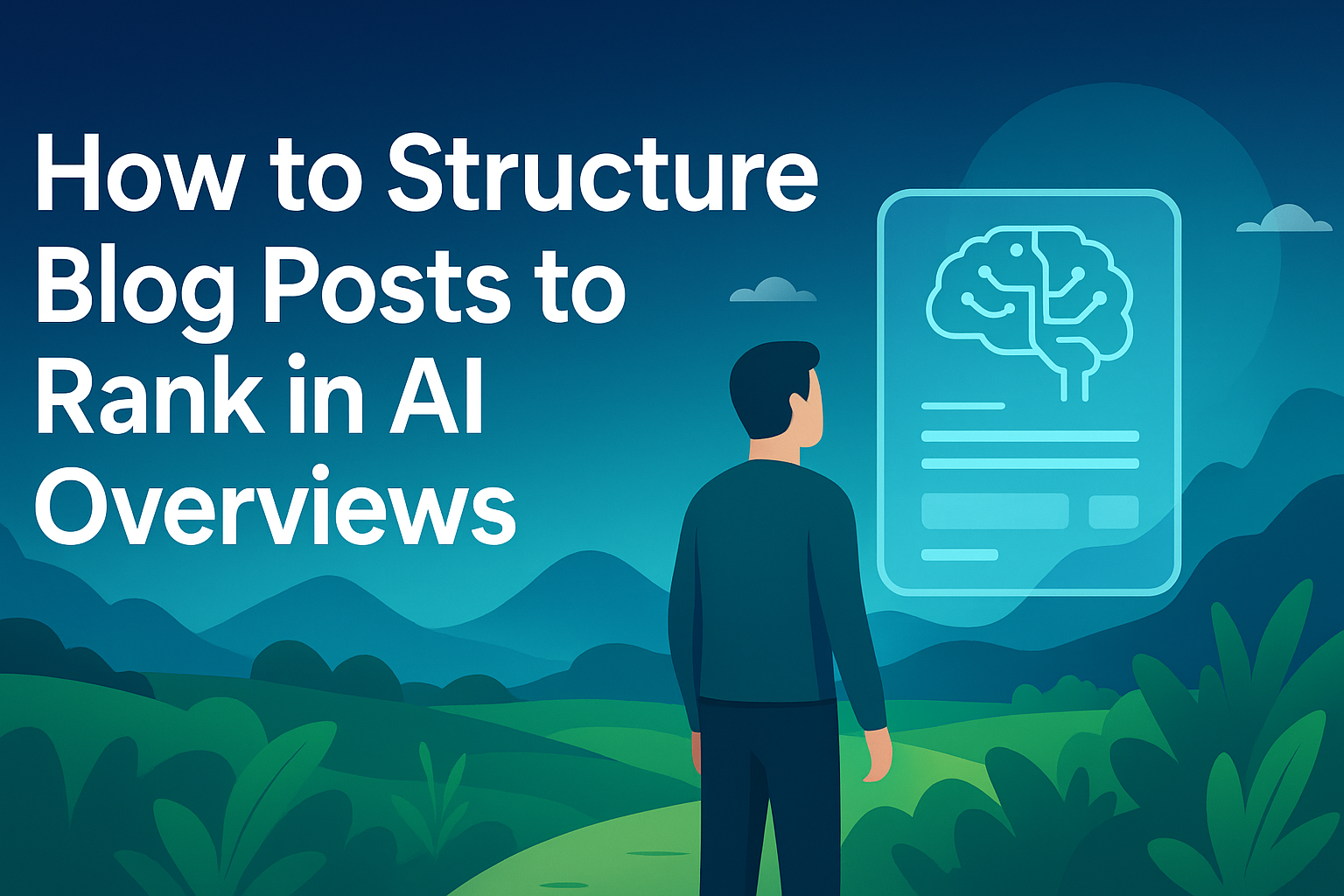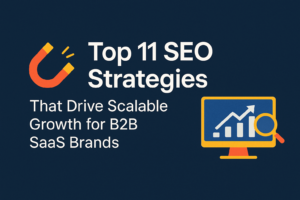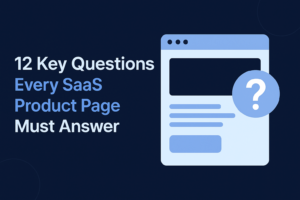AI-powered search is here, and it’s changing the way buyers consume content. With AI Overviews now showing up at the very top of Google SERPs, traditional “rank #1” SEO is no longer enough. These summaries pull answers from multiple sources and cite them directly meaning, if your blog isn’t optimized for this new format, you risk becoming invisible.
For SaaS marketers, content strategists, and B2B brands, this means rethinking how we structure blog posts. It’s no longer enough to optimize for SEO; now, your content must serve both human readers and AI-driven summarization models. For B2B SaaS marketers, this change is huge. Buyers are already research-heavy, consuming 3–7 touchpoints before engaging with sales (Gartner, 2023). If AI Overviews shorten that journey by condensing insights into a single box, your brand needs to be one of the cited voices—or you’ll be skipped entirely.
This guide goes beyond surface tips. We’ll unpack 15 plays to structure blog posts for AI Overview visibility, complete with live examples, citations, and actionable strategies you can apply today.
What Are AI Overviews?
According to Google’s official documentation on AI Overviews, these are AI-generated summaries that appear at the top of results pages. They aim to provide direct, conversational answers to search queries, often with citations to 2–5 sources.
Think of them as a knowledge shortcut. If your blog provides the clearest, most structured, and credible answer to a query, Google is more likely to surface and cite it in an AI Overview.
What Google’s AI Overviews Mean for Your SaaS Content?
A McKinsey survey (2024) showed that buyers now spend only 17% of their time talking to vendors before making a purchase decision the rest is spent on research. If AI Overviews are compressing that research phase, your content needs to appear at the earliest, most influential point.
This makes AI Overview optimization not just an SEO concern, but a demand generation play. Citations inside AI Overviews can:
- Build brand authority at the start of the buyer journey
- Increase trust, even if the buyer doesn’t click immediately
- Position your SaaS product as a category leader before competitors get noticed
15 Proven Ways to Structure Blog Posts for AI Overview Rankings
1. Lead with a One-Paragraph Answer
AI Overviews scan the first 75–100 words for direct answers. For example, HubSpot’s blog consistently opens with a clear definition or summary:
“Content marketing is the process of planning, creating, distributing, and analyzing content to attract and convert prospects into customers.” (HubSpot Blog, 2024)
This format makes it easy for Google to extract and cite. If your blog topic is “What is AI Overview SEO?”, start with:
AI Overview SEO is the process of structuring and optimizing blog content so it can be cited in Google’s AI-generated summaries, which appear at the top of search results.
2. Use Scannable H2s and H3s
Google prefers structured, hierarchical content. Subheadings written in natural question form align with conversational search queries.
Example:
- Weak: “Blog Optimization Tips”
- Strong: “How Do You Optimize Blog Posts for AI Overviews?”
A great live example is Ahrefs’ guide “What is Keyword Difficulty?” every H2 matches a real search question, increasing extractability.
3. Add Definition Boxes
Clear definitions increase your chances of being featured. Neil Patel’s SEO glossary does this well by isolating key terms in styled callout boxes.
Example for your blog:
📌 Definition: AI Overview
An AI Overview is Google’s AI-generated summary that synthesizes answers from multiple sources and cites them directly within the search results.
👉 Use consistent formatting like bold headers or shaded boxes.
4. Include a TL;DR Section
Readers skim. Google extracts. A TL;DR serves both.
Example: Backlinko’s “SEO Copywriting Guide” starts with a summary of takeaways before diving deeper. AI systems favor this because it’s concise and structured.
Your TL;DR could include:
- What AI Overviews are
- Why they matter for SaaS SEO
- The 15 structural plays
5. Use Tables for Quick Reference
Tables make structured data more accessible. For example, G2’s comparison pages often rank in AI snippets because they use tables for side-by-side product comparisons.
Your blog could include a table like:
| Section | Placement | AI Overview Benefit |
|---|---|---|
| One-Paragraph Answer | Intro (75–100 words) | Extractable summary |
| TL;DR | After intro | Concise reference |
| FAQs | End of post | Matches conversational queries |
6. Add FAQ Sections
Google’s own Search Central recommends FAQ schema for AI-readability.
Example: SEMrush’s content often ends with FAQs like:
- What is keyword difficulty in SEO?
- How do you calculate it?
This format makes them a recurring citation in SERPs.
7. Use Schema Markup
Schema is like metadata on steroids. According to Search Engine Journal (2024), adding FAQPage, HowTo, and Article schema boosts extractability in AI-driven results.
Example: A B2B SaaS blog about “CRM integrations” could mark up its How-To steps for setup, making it more eligible for Overview inclusion.
8. Show Real Experience (E-E-A-T)
Google’s quality guidelines emphasize Experience. Don’t just say “AI Overviews matter”—show screenshots, experiments, or client case studies.
Example: Animalz often shares charts from their own SaaS content campaigns. This “evidence-first” approach gets cited because it’s harder to replicate.
9. Cite Authoritative Sources
AI Overviews prefer trusted references. Link to:
- Google’s Search Central Blog
- Industry authorities (Search Engine Land, Gartner, HBR)
- Academic or survey-based reports
Example: In this post, citing Gartner’s B2B buying journey adds credibility.
10. Build Topic Clusters
Don’t write one-off posts. Instead, create a pillar page (e.g., The Ultimate Guide to AI Overview SEO) and cluster content around subtopics (e.g., schema optimization, FAQ best practices).
HubSpot’s “Marketing Hub” content model is a perfect case study by interlinking, they dominate clusters like inbound marketing.
11. Add Explainer Visuals
Visuals boost dwell time (a ranking signal) and enhance multimodal extraction.
Example: Moz often uses process diagrams (e.g., link building flows) which get widely cited in third-party articles—another trust signal.
For your blog: a diagram showing “Where to Place Key Elements in a Blog Post for AI Overviews”.
12. Be Transparent About Trade-Offs
Google values balanced content. Instead of just praising AI Overviews, also explain risks (like reduced organic clicks).
Example: Content Marketing Institute’s reports often highlight both opportunities and challenges, building trust and authority.
13. Refresh Content Regularly
Freshness is critical. According to Google’s documentation, freshness signals include:
- Adding new statistics
- Updating publication dates
- Refreshing examples
Example: Ahrefs updates core guides (like their SEO Basics) every year, keeping them eligible for new AI citations.
14. Use Descriptive Anchor Text
Anchor text helps AI contextualize sources. Instead of “read here,” use “Google’s AI Overview announcement.”
Example: Zapier’s blog is a masterclass—they use descriptive anchors for every internal and external link, boosting clarity.
15. End with a Checklist + CTA
Wrap your post with a step-by-step checklist and a clear next action.
Example: Buffer ends many guides with an actionable “try this today” CTA, making their content both reference-worthy and conversion-friendly.
Checklist Example for You:
- ✅ Start with a one-paragraph answer
- ✅ Add a TL;DR + tables
- ✅ Mark up FAQs with schema
- ✅ Cite authoritative sources
- ✅ Refresh content quarterly
Then close with: “Want help future-proofing your SaaS blog for AI Overviews? Let’s connect.”
The New Playbook for AI-First SEO
The rise of AI Overviews signals a fundamental shift in how visibility, authority, and influence are earned online. Traditional “rank-and-wait” SEO is no longer enough—Google’s generative engine now demands content that is clear, structured, authoritative, and evidence-backed.
For B2B SaaS brands, the implications are massive. The buyer journey is already shorter and more self-directed than ever before (Gartner, 2023). AI Overviews compress that journey further, surfacing answers instantly and shaping perceptions before a prospect even visits your website.
The 15 plays we’ve covered in this guide from leading with concise answers to embedding schema, visuals, and lived experience—are not just tactics. Together, they form a new playbook for content that thrives in an AI-first search environment.
But here’s the key: this isn’t a one-off project. It’s a systematic discipline. Blogs must be refreshed, FAQs expanded, and clusters built continuously if you want to earn and maintain your place in AI Overviews.
The brands that adapt fastest will own the conversation. Those that don’t risk becoming invisible—outpaced by competitors who recognized that AI Overview optimization is both an SEO strategy and a demand-generation multiplier.
So ask yourself:
👉 Will your content be summarized by AI as a trusted authority?
👉 Or will it be summarized about you—without you?
The choice depends on how quickly you embrace this shift. Start today, test relentlessly, and let your expertise shape the future of how buyers discover, trust, and choose your brand.
Your Questions on Blog Structuring for AI Overviews, Answered
1. What exactly are AI Overviews, and should I still follow traditional SEO best practices?
AI Overviews are concise, AI-generated summaries that appear at the top of some Google search results aimed at giving users quick, synthesized answers. According to Google Search Central, all existing SEO guidelines remain relevant: if your page is indexable, technically sound, and written with user-first intent, it’s eligible to be cited in these Overviews.
2. Do FAQs still benefit visibility, even though Google reduced FAQ rich snippets?
Yes, they absolutely do. While Google may limit FAQ snippets from appearing in traditional results, FAQ content remains highly valuable for AI search and overview extraction. Pages enriched with FAQ schema have improved content structure and find a place in AI-generated summaries.
3. How should FAQ content be structured for maximum AI visibility?
For best results, write each FAQ as a clear question ideally under 15 words followed by a concise answer (30–50 words) that clearly addresses only that question. Use JSON-LD markup and avoid hiding content behind tabs or accordions, as search engines must be able to crawl and parse it easily.
4. Which schema types support inclusion in AI Overviews or conversational search?
Include structured data like FAQPage, HowTo, Article, Person—and in certain cases, QAPage. These schema types help search engines parse your content and increase its chances of being surfaced in AI-generated summaries.
5. How frequently should I monitor and update content targeting AI Overviews?
Consistency matters. SE Ranking’s research shows that AI Overviews frequently cite pages ranking within the top 10 organic results—92% of the time, especially when they’re fresh and regularly updated. Monitor your citations, experiment, and iterate content based on what patterns emerge in current AI Overviews.
6. Does structuring content purely for AI interfere with user experience?
Not at all—good structure benefits both users and AI. As experts explain, AI favors content that is clear, scannable, and rich with expertise (E-E-A-T). Using natural questions, short paragraphs, contextual examples, and clean formatting helps readers and machines alike. It’s not just a smart tactic it enhances readability too.

vetrivel is an accomplished SEO and digital marketing expert with 5 plus years of experience. dedicated to providing readers with informative and engaging content.




